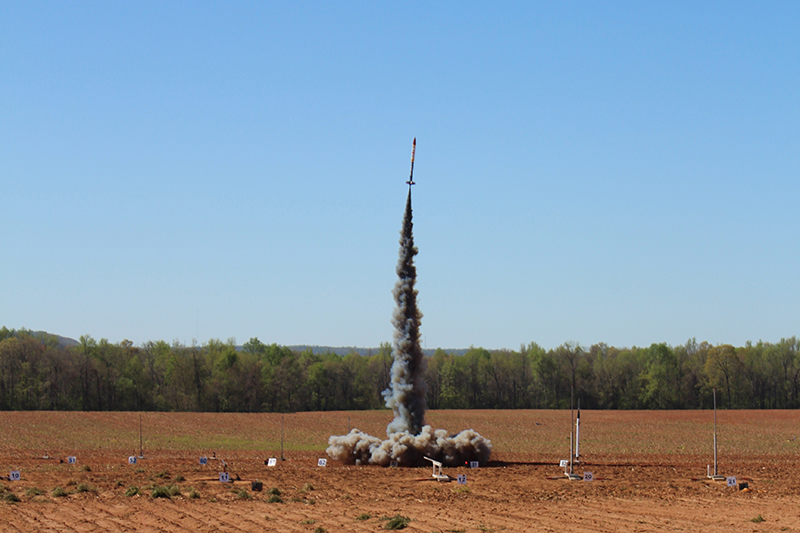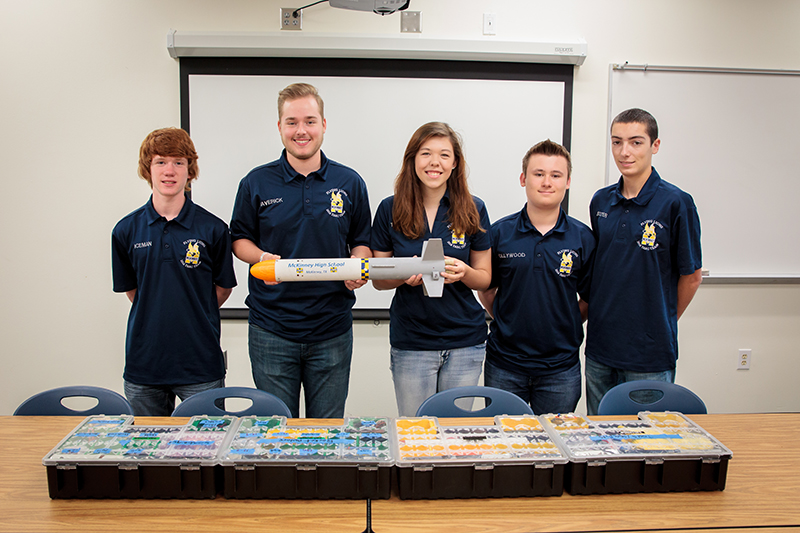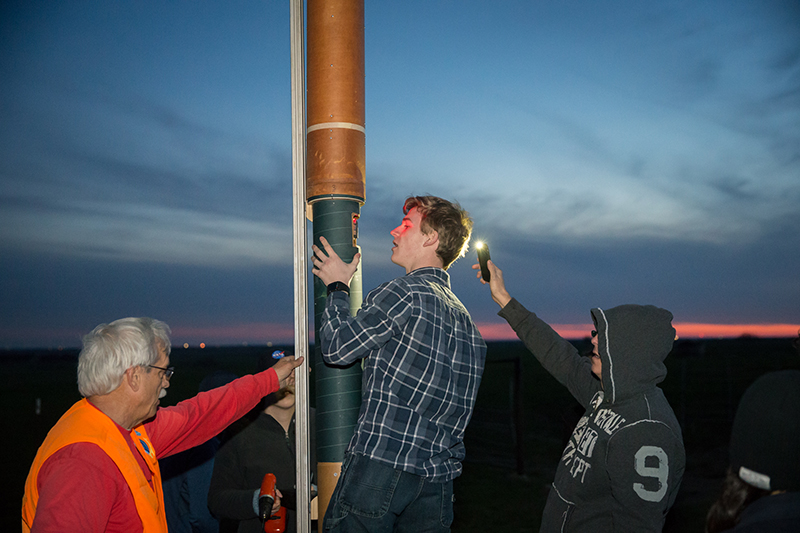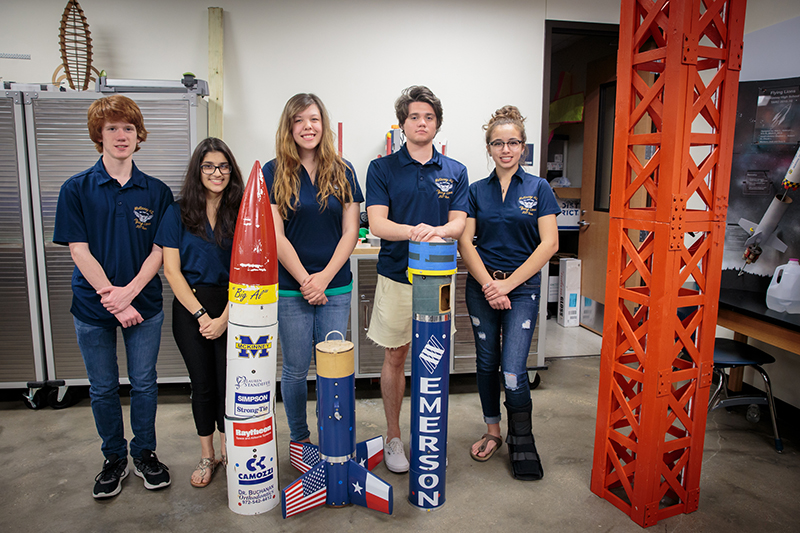A Rocketry Team from MHS Takes on the College Crowd at the NASA Student Launch Initiative
McKinney, Texas – To the uninitiated, watching from where the audience stood hundreds of feet away, it looked very much like a toy.
But, when the countdown from the P.A. announcer reached “One!” and the command to “Launch!” was given, the sudden blast of flame and skyrocketing plume of black smoke quickly drove home the fact that this was no plaything. The 8-foot tall rocket blasted into the sky over Bragg Farms in Toney, Alabama near NASA’s Marshall Space Flight Center for the 2017 NASA Student Launch Initiative (SLI) held April 5 – 9.
As the rocket climbed overhead, the team of eight students from McKinney High School who built it looked on anxiously. This launch marked the conclusion of a long journey.
And, the final mile belonged to the rocket.
As it soared toward its target altitude one mile above the watching crowd, the P.A. announcer’s voice became increasingly strident. “A little bit of a tail wiggle. It’s arcing over the crowd. We’re looking for an event…We’re counting pieces in the air…Everybody point at the rocket…There’s a piece falling! Heads up!”
Someone blasted an air horn. “There’s a piece falling near the flight line!”
“Everybody point at the piece!” The air horn sounded a double blast.
“Heads up!” A triple blast from the air horn…

The MHS Flying Lions’ rocket launches at the NASA Student Launch Initiative in Alabama.
The Beginning
The journey to Alabama and the 2017 NASA SLI began nearly two years earlier when a group of five MHS students—Eric Beights, Alex Lehocky, Kathryn Lehocky, Mitchell Palmer and William Slater—approached their engineering teacher, Robert Gupton, about putting together a team to tackle the 2016 Team America Rocketry Challenge (TARC).
The “challenge” in that national contest called for student teams to design, build and launch a mid-powered, class “F” rocket (about three feet in length) 825 feet skyward with a fragile payload—in this case, two raw eggs—and return the payload safely to earth within a span of 44 – 46 seconds. Deviation above or below the time window and altitude meant added points, and the TARC teams didn’t want points. Victory was awarded to the team with the score closest to zero. Damage to the egg would result in automatic disqualification.
The Flying Lions’ first major hurdle was to qualify for the National Fly-Off in Washington, D.C. by posting a launch score among the top 100 of the 700-or-so teams competing across the country. No problem. The team posted a qualifying score that was better than the previous year’s national winner.
Once in D.C., they soared over the next hurdle by earning a Round 1 score that landed them in second place going into the TARC Final Round. They were poised to win the whole thing.
Then the weather turned and storms rolled in, and a rocket engine misfired. And, the Flying Lions didn’t finish as well as they had hoped.
But, what they did accomplish was…well, making it to the top 25 of the TARC National Finals on their very first attempt and securing a berth in the 2017 NASA Student Launch Initiative as one of only 25 high school or middle school teams from across the country invited to compete.
The remaining SLI teams would be made up of rocketry teams from universities all over the country that included groups from Cornell, Vanderbilt, Notre Dame and the U.S. Naval Academy. Of the 25 high school teams who qualified, only about 12 would actually go on to launch a rocket in Alabama, according to the team.
This competition was not for the fainthearted.

The Flying Lions 2016 team with their TARC rocket: (l-r) Eric Beights, William Slater, Kathryn Lehocky, Alex Lehocky and Mitchell Palmer
NASA
With a year in front of them to prepare, the NASA launch project presented new challenges. First of all, the team would lose veteran member William Slater to graduation. Then, over the summer, team mentor Stephen Lehocky had to obtain special certification that would qualify him to oversee the launch of the Level 2 rocket used for the NASA challenge—a rocket about 5 ft. longer than the one built for TARC, with an engine approximately 64 times more powerful.
The nucleus of the NASA team would carry over from the previous year’s TARC group—Eric Beights, Alex Lehocky, Kathryn Lehocky and Mitchell Palmer. Rounding out the group were newcomers Jason Beights, Shuva Gautam, Alex Macias and Kyle Myscich.
From the beginning, the kids from MHS demonstrated a tenacity that has proven to be essential for teams who aspire to compete at this level.
“These had to be the type of kids that don’t give up, and they complete everything,” said Gupton. “That would be a minimum requirement. They have to have that kind of integrity — ‘I’ve bought into this; I’m going to finish it.’”
The NASA project would require an incredible time commitment if the team wanted any shot at success—sometimes 20 hours a week on top of the team members’ normal workload, and for a few weeks as they neared the event date, as many as 40 hours a week.
“It was a very long process,” said Kathryn. “It took a few months and really, really, really late nights here at school. I think the latest we stayed one night was around midnight or 1 a.m. just working on the rocket. When we got close to the competition, we were here late every night—at least until 8 o’clock…trying to finish up the rocket.”
But, beyond the arduous time commitment, the rocket design itself was challenging even at the most basic level. Even so, the MHS team wasn’t interested in shooting for the minimum expectation.
“[For the NASA Student Launch], the high schools were basically given the task to build a rocket so that it goes up to a mile and comes down safely,” said Alex Macias. “So, we did that aspect—and we just decided to [also] take on two of the university challenges.”
Specifically, those challenges involved a fragile payload and the design and construction of a drone that would be deployed during the launch and programmed to automatically return to a landing zone beacon.
It was a daunting task, to be sure, and an expensive proposition. They did have rather weighty supporters in their corner, though. Raytheon Company and Emerson Process Management in McKinney each donated money and offered the use of equipment such as high-end 3D printers to fabricate parts. Simpson Strong-Tie helped out with supplies and sponsorship, and Jack and Suzy Sprague from the Dallas Area Rocket Society served as mentors along with Stephen Lehocky and others.
Things were looking up, and moving forward and before long, the time arrived for test launches.
Stormy Weather & Silver Linings
March 3 rolled around, and the team had high hopes. Showers earlier in the week had saturated the ground, but a couple of days of springlike weather had made good headway toward firming things up. The team loaded up their rocket and their equipment and caravanned off into the lush, rolling countryside outside of Gunter about 30 miles northwest of McKinney.
It was time at last to put the rocket through its first full-scale launch. A few weeks prior, the team had successfully fired off a half-scale model. Now, it was time to light the fuse on the big one.
Almost immediately, there were issues. Several vehicles bogged down in the unexpectedly marshy, low-lying areas of the field through which the team had to pass to reach the launch site, and a couple of them had to be pulled through the slippery mire with a four-wheel drive and a tow rope.

Kyle Myscich works in the fading light to prep the rocket for its first full scale test launch attempt.
Wind became a potential problem as the sunny afternoon began to turn unexpectedly cold and gusty. And, as the team worked to assemble the rocket’s outer shell and internal electronics, time became a pressing issue as the afternoon sun sank ever closer to the horizon.
A NASA SLI college team from a nearby university was also onsite for a test launch, and both they and the Flying Lions lost precious time as the ignition system being used by both teams failed to fire the other team’s rocket. Trouble-shooting efforts revealed and corrected the issue, but the delay cost nearly an hour.
With the light quickly fading, the launch site was prepped at last, and the MHS team moved quickly to get the rocket mounted on the launch rail—only to find in the end that their laptop, which communicated with the rocket’s onboard electronics and GPS device, had gone dead. A launch now, without the GPS, in the dark, would make it almost impossible to recover the rocket.
The launch had to be scrapped.
With few words and illuminated by the harsh glare of a line of car headlights, the Flying Lions began to disassemble their rocket and pack up for the long drive back to McKinney. They would have to test another time. But, the window to do so was shrinking.
What they discovered later, though, revealed a silver lining in the disappointing expedition. A structural flaw that the team had overlooked during assembly would have resulted almost certainly in a catastrophic failure that would have destroyed the rocket if they had actually launched that afternoon. It would have spelled the end of their efforts, for they most likely would not have had time to build a new rocket in the time window that remained to report test launch results to NASA.
But, with their rocket still in good shape, they trekked once again to Gunter the following week, and things went very differently. That was followed by another test in late March.
They were building momentum, and they were nearing the conclusion of their journey.
The Final Mile
“Heads up!” A triple blast from the air horn…
The nosecone of the Flying Lions’ rocket was hurtling unceremoniously toward the rich earth of Bragg Farms. Nestled within it were the drone and the fragile cargo components. It was not definitively clear what caused the nosecone to separate prematurely, but when it did, it set off a chain reaction of issues that included problems with the drone.
“We had done some ejection charge testing with the drone, but we hadn’t really tested the flight process or landing it,” Alex Macias explained. In light of that, NASA had asked them not to deploy the drone to fly to a designated landing zone, but rather to simply have it return via parachute alongside the fragile payload. When the nosecone separated early, it damaged the parachute mechanism for the drone, and the drone did not eject from the cone.
The nosecone rotated and tumbled end over end as it descended.
Suddenly, a burst of color emerged from the tube, and the nosecone’s parachute unfurled and filled with air—then almost immediately ripped away as the damaged connectors were overwhelmed by the speed of the descent.

Members of the MHS Flying Lions team with the rocket they launched at the 2017 NASA Student Launch Initiative. Pictured here are (l-r) Eric Beights, Shuva Gautam, Kathryn Lehocky, Jason Beights and Alex Macias. (Not pictured are team members Alex Lehocky, Kyle Myscich and Mitchell Palmer.)
NASA officials realized that the falling piece was clear of the flight line and away from the crowd and that nobody was in danger. The blaring air horn finally went silent, and the crowd watched quietly as the nosecone arrived with a dismal thump. In its wake, the remaining rocket sections descended gracefully over the launch area beneath the canopy of their own successfully deployed parachutes.
As dramatically as it all unfolded and as catastrophic as it all seemed in the moment, the effort was far from a defeat. The basic requirement for high school teams was to design and build a rocket that could achieve an altitude of at least one mile.
The Flying Lions did that.
The voluntary, university-level challenges they undertook showed great engineering promise. The protective capsule which contained the fragile payload—five clay disks—crashed down with the nosecone. Only one disk was damaged.
They designed and built a functional drone.
And, this team of high school kids earned the respect of a lot of engineering students.
“During the rocket fair, university students were coming up to us, and we would talk about our project, and they’d look down at our name tags, and it would say ‘High School,’ and they were like, ‘Oooh,’” laughed Alex Macias. “It was a cool experience to be recognized by university kids because they were impressed by our rocket. We’re pretty proud.”
They should be.
They also won the NASA SLI Rocket Fair Display Award (Middle/High School Division), which, as the name implies, was presented to the middle or high school team with the best display at the Student Launch Rocket Fair.
Beyond all of that, this team of Flying Lions bested nearly 80 of the best middle and high school rocketry teams in the country to earn their spot on the NASA SLI launch pad.
“Most of these kids…when they work on teams at school, they are the team lead,” Gupton said. “They are that type of kid, and they can usually complete a project by themselves. But, doing a project like this, they realized, ‘This is bigger than me.’ And, it would not be possible for an individual to be able to do it. I think it was an eye opening experience where they’ve had to work as a team because it wasn’t possible to do it on your own.”
And, that’s really a good thing. Because, when kids like that circle up, learn from each other and refuse to give up…
They can really soar.
Need Help?
If you need additional assistance with the content on this page, please contact MISD Communications Department team member Shane Mauldin by phone at 469-302-4007 or by email here .